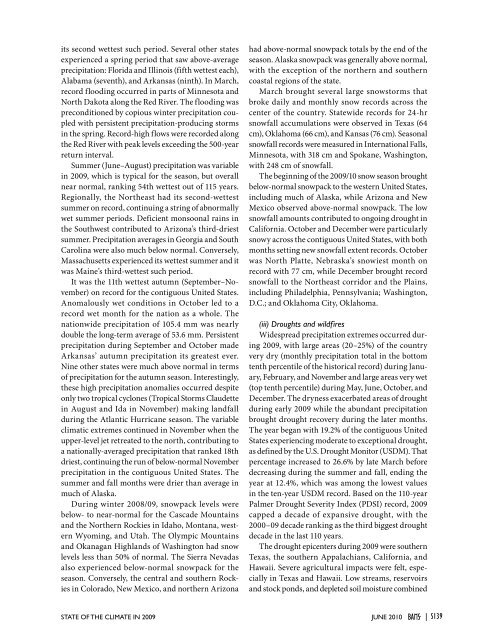You also want an ePaper? Increase the reach of your titles
YUMPU automatically turns print PDFs into web optimized ePapers that Google loves.
its second wettest such period. Several other statesexperienced a spring period that saw above-averageprecipitation: Florida and Illinois (fifth wettest each),Alabama (seventh), and Arkansas (ninth). In March,record flooding occurred in parts of Minnesota andNorth Dakota along the Red River. The flooding waspreconditioned by copious winter precipitation coupledwith persistent precipitation-producing stormsin the spring. Record-high flows were recorded alongthe Red River with peak levels exceeding the 500-yearreturn interval.Summer (June–August) precipitation was variablein <strong>2009</strong>, which is typical for the season, but overallnear normal, ranking 54th wettest out of 115 years.Regionally, the Northeast had its second-wettestsummer on record, continuing a string of abnormallywet summer periods. Deficient monsoonal rains inthe Southwest contributed to Arizona’s third-driestsummer. Precipitation averages in Georgia and SouthCarolina were also much below normal. Conversely,Massachusetts experienced its wettest summer and itwas Maine’s third-wettest such period.It was the 11th wettest autumn (September–November)on record for the contiguous United States.Anomalously wet conditions in October led to arecord wet month for the nation as a whole. Thenationwide precipitation of 105.4 mm was nearlydouble the long-term average of 53.6 mm. Persistentprecipitation during September and October madeArkansas’ autumn precipitation its greatest ever.Nine other states were much above normal in termsof precipitation for the autumn season. Interestingly,these high precipitation anomalies occurred despiteonly two tropical cyclones (Tropical Storms Claudettein August and Ida in November) making landfallduring the Atlantic Hurricane season. The variableclimatic extremes continued in November when theupper-level jet retreated to the north, contributing toa nationally-averaged precipitation that ranked 18thdriest, continuing the run of below-normal Novemberprecipitation in the contiguous United States. Thesummer and fall months were drier than average inmuch of Alaska.During winter 2008/09, snowpack levels werebelow- to near-normal for the Cascade Mountainsand the Northern Rockies in Idaho, Montana, westernWyoming, and Utah. The Olympic Mountainsand Okanagan Highlands of Washington had snowlevels less than 50% of normal. The Sierra Nevadasalso experienced below-normal snowpack for theseason. Conversely, the central and southern Rockiesin Colorado, New Mexico, and northern Arizonahad above-normal snowpack totals by the end of theseason. Alaska snowpack was generally above normal,with the exception of the northern and southerncoastal regions of the state.March brought several large snowstorms thatbroke daily and monthly snow records across thecenter of the country. Statewide records for 24-hrsnowfall accumulations were observed in Texas (64cm), Oklahoma (66 cm), and Kansas (76 cm). Seasonalsnowfall records were measured in International Falls,Minnesota, with 318 cm and Spokane, Washington,with 248 cm of snowfall.The beginning of the <strong>2009</strong>/10 snow season broughtbelow-normal snowpack to the western United States,including much of Alaska, while Arizona and NewMexico observed above-normal snowpack. The lowsnowfall amounts contributed to ongoing drought inCalifornia. October and December were particularlysnowy across the contiguous United States, with bothmonths setting new snowfall extent records. Octoberwas North Platte, Nebraska’s snowiest month onrecord with 77 cm, while December brought recordsnowfall to the Northeast corridor and the Plains,including Philadelphia, Pennsylvania; Washington,D.C.; and Oklahoma City, Oklahoma.(iii) Droughts and wildfiresWidespread precipitation extremes occurred during<strong>2009</strong>, with large areas (20–25%) of the countryvery dry (monthly precipitation total in the bottomtenth percentile of the historical record) during January,February, and November and large areas very wet(top tenth percentile) during May, June, October, andDecember. The dryness exacerbated areas of droughtduring early <strong>2009</strong> while the abundant precipitationbrought drought recovery during the later months.The year began with 19.2% of the contiguous UnitedStates experiencing moderate to exceptional drought,as defined by the U.S. Drought Monitor (USDM). Thatpercentage increased to 26.6% by late March beforedecreasing during the summer and fall, ending theyear at 12.4%, which was among the lowest valuesin the ten-year USDM record. Based on the 110-yearPalmer Drought Severity Index (PDSI) record, <strong>2009</strong>capped a decade of expansive drought, with the2000–09 decade ranking as the third biggest droughtdecade in the last 110 years.The drought epicenters during <strong>2009</strong> were southernTexas, the southern Appalachians, California, andHawaii. Severe agricultural impacts were felt, especiallyin Texas and Hawaii. Low streams, reservoirsand stock ponds, and depleted soil moisture combined<strong>STATE</strong> <strong>OF</strong> <strong>THE</strong> <strong>CLIMATE</strong> <strong>IN</strong> <strong>2009</strong> juNE 2010 |S139
















